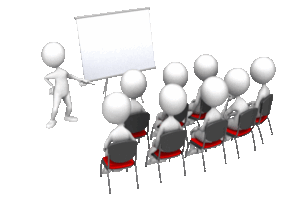Training – Do It Yourself or Outsource It?
 Maybe you want to develop your own materials and conduct classes or training. Maybe you want to hire me or someone else for those tasks. Regardless, creating effective training presentations requires some in-depth thought and planning. These guidelines can help you focus clearly as you get started. The concepts apply equally in preparing you 1) to create and present classes and 2) to evaluate and hire training contractors. Also, the considerations are similar for a speech or single class presentation and for a longer course or class modules.
Maybe you want to develop your own materials and conduct classes or training. Maybe you want to hire me or someone else for those tasks. Regardless, creating effective training presentations requires some in-depth thought and planning. These guidelines can help you focus clearly as you get started. The concepts apply equally in preparing you 1) to create and present classes and 2) to evaluate and hire training contractors. Also, the considerations are similar for a speech or single class presentation and for a longer course or class modules.

 Note: this is the first in a series about how to create effective classes, training, and other presentations. I’m trying to spare your eyes from reading fatigue. Each sub-topic could be a whole book or a whole post!
Note: this is the first in a series about how to create effective classes, training, and other presentations. I’m trying to spare your eyes from reading fatigue. Each sub-topic could be a whole book or a whole post!
Training Scope and Limitations
 Begin by creating a general outline of your thoughts and goals. That outline is not a law! You don’t have to adhere to it!
Begin by creating a general outline of your thoughts and goals. That outline is not a law! You don’t have to adhere to it!
 It is food for thought and an aid in getting things organized. You will change the content and flavor by adding or omitting ingredients as you cook it until it’s well done. In that process, you will define the scope and limitations of the following:
It is food for thought and an aid in getting things organized. You will change the content and flavor by adding or omitting ingredients as you cook it until it’s well done. In that process, you will define the scope and limitations of the following:
The Training or Speech Topic

Rather than choosing “World Peace” as an overly broad topic, select one aspect. Here are some examples.
- Teach people how to meditate as a contribution to world peace. (It’s easier than you think.)
- Train employees in negotiation and mediation skills to bring peace to a contentious workplace.
- Talk about how learning a new technology, in a safe and non-judgmental environment, will give them job security and peace of mind as they take on new job responsibilities.
Choose a topic that is as relevant as possible to the daily lives and/or interests of your trainees. That, of course, implies you need to know some details about your audience.
Effective Training is About Excellent Communication

Sometimes we want to correct a behavior. At times, we want to inculcate new skills. We may want to expand on existing creativity or knowledge in our students. Sometimes, we just want to share new things we’ve learned. Intended goals, according to the Business Dictionary, include the objectives of:
- Creating awareness
- Imparting knowledge
- Projecting an image
- Shaping attitudes
- Stimulating a want or desire, and/or
- Effecting a sale.
The components of communication are not just a speaker speaking. For in-depth learning to take place, both trainer and trainee must have:
- Active listening skills
- Ability to anticipate objections and to answer those negatives before they are solidified beyond correction in the person’s mind
- Receptivity to learning
- Willingness to understand new information or points of view or which conflict with pre-existing beliefs
- A safe and supportive environment.

Stop talking on your cell phone!
It helps if trainer and trainees have shared goals, values, ethics, and respect for classroom etiquette. Oh well!
The truth is that we sometimes have to teach or train people who are resistant to us or to the topic. This is especially true if the trainees are fearful that they cannot learn sufficiently well to perform new tasks in a work environment.
 It also is true that young people may be perfectly comfortable in learning things through online videos. Conversely, adult learners might prefer sharing experiences as the way they learn best in an in-person environment.
It also is true that young people may be perfectly comfortable in learning things through online videos. Conversely, adult learners might prefer sharing experiences as the way they learn best in an in-person environment.
 There are other differences affecting the ability to receive and retain training. They relate to culture, education, sociology, and field of work. Individual attention may be required.
There are other differences affecting the ability to receive and retain training. They relate to culture, education, sociology, and field of work. Individual attention may be required.

 Similarly, you could change your training approach for Business to Customer classes versus Business to Business classes.
Similarly, you could change your training approach for Business to Customer classes versus Business to Business classes.
For us to design successful training presentations, we need to consider the following.
Characteristics of the Trainees / Audience
To whom are you speaking?
Be aware of the level of education and language skills of the trainees.
 I once had to conduct training on the same complex subject (government procurement policies, procedures, and related software navigation) to people who were groundskeepers, administrative staff, and Ph.D. instructors at Northern Virginia Community College. It is the second largest community college in the USA. Each person had very different roles on campus and needed to know only portions of the overall content.
I once had to conduct training on the same complex subject (government procurement policies, procedures, and related software navigation) to people who were groundskeepers, administrative staff, and Ph.D. instructors at Northern Virginia Community College. It is the second largest community college in the USA. Each person had very different roles on campus and needed to know only portions of the overall content.- The best case scenario would have been to divide into groups. This approach would have allowed content and style to be customized to the very different needs and sophistication of each.
- Since that was not possible because of time constraints, I had to make sure I used a variety of language and examples to which people in each department could relate.
 The subject matter was tough and potentially boring, but “a good time was had by all.” A further advantage of having such a diverse group of trainees in the same class was that they began to understand one another’s perspectives in ways they would not have done without this in-person exposure to one another’s questions and viewpoints. Each person had a piece of the puzzle that makes the whole operation work well for customers.
The subject matter was tough and potentially boring, but “a good time was had by all.” A further advantage of having such a diverse group of trainees in the same class was that they began to understand one another’s perspectives in ways they would not have done without this in-person exposure to one another’s questions and viewpoints. Each person had a piece of the puzzle that makes the whole operation work well for customers.
Be mindful of the general frame of reference of the trainees and accommodate that in your approach to creating classes, training materials, and scenarios.
 Respect your students. For example, if you’re teaching computer skills to people who fear technology, the approach should be different from that used to training people who thrive on the use of technology in their daily lives.
Respect your students. For example, if you’re teaching computer skills to people who fear technology, the approach should be different from that used to training people who thrive on the use of technology in their daily lives.- Do not use “jargon” in your presentations, unless the trainees already are thoroughly familiar with that jargon, acronyms, abbreviations, etc.
- Be as formal or informal as need be to communicate effectively with the particular group you are training.
Company Training Classes for Groups
 If possible, seek 360-degree input. Even if you’re training on a technical subject, it is likely that company policies and procedures apply. Different folks have responsibility for differing parts of the organization’s mission and for customer service.
If possible, seek 360-degree input. Even if you’re training on a technical subject, it is likely that company policies and procedures apply. Different folks have responsibility for differing parts of the organization’s mission and for customer service.
It is important to know the goals and objectives of upper management or a Board of Directors. It’s also critical to know what challenges “worker bees” face, particularly as relates to customer service. Trainees may know the real world situation better than company leadership, but upper management may need to meet specific requirements.
 By listening to people from all affected parts of an organization (and to customers, if possible), you can create the best training to serve the purpose at hand. In that process, you also have an opportunity to explain the situation and needs of each level OF the organization TO each level of the organization. This can enhance the sense of shared goals, objectives, and desire for success.
By listening to people from all affected parts of an organization (and to customers, if possible), you can create the best training to serve the purpose at hand. In that process, you also have an opportunity to explain the situation and needs of each level OF the organization TO each level of the organization. This can enhance the sense of shared goals, objectives, and desire for success.
Once you have all that input, however, it is time to do the work with a very limited number of “co-conspirators.” Remember: Too Many Cooks Can Spoil the Broth.”
Company Training Classes for Individuals
 If this training is to correct a performance issue, discuss the training needs and objectives during the performance evaluation. After describing any shortcomings, provide details needed in the Next Steps to correct a deficiency. There might be no deficiency, but you or the employee would like for the person to qualify for a promotion which requires expanded skills. In each case, you should provide follow-up meetings and training opportunities.
If this training is to correct a performance issue, discuss the training needs and objectives during the performance evaluation. After describing any shortcomings, provide details needed in the Next Steps to correct a deficiency. There might be no deficiency, but you or the employee would like for the person to qualify for a promotion which requires expanded skills. In each case, you should provide follow-up meetings and training opportunities.
The Training Facility (Real or Imagined = Physical or Online)
 I was going to talk just about the things you need to scout out about the training venue. However, I’ve decided to go above and beyond the call of duty and give you a checklist I developed some time ago for presenters to use in thinking about their approaches to a speech. Because that is so long, thorough, and complex, I’m putting this wonderful aid into a separate blog, so please come back for more!
I was going to talk just about the things you need to scout out about the training venue. However, I’ve decided to go above and beyond the call of duty and give you a checklist I developed some time ago for presenters to use in thinking about their approaches to a speech. Because that is so long, thorough, and complex, I’m putting this wonderful aid into a separate blog, so please come back for more!
Do It the Write Way! Let My Fingers Do Your Talking!
